Mazda Mazda3
Front Brake Pads Replacement Guide
How to change the front brake pads of a
2nd generation 2010 to 2013 Mazda Mazda3 with photo illustrated steps.
By Paul B. Michaels Author & Photographer Auto Mechanic Since 1989 |
||
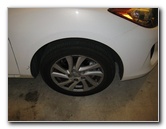 2012 Mazda3 Front Wheel |
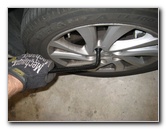 Slightly Loosen Lug Nuts |
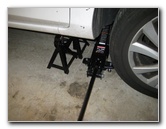 Raise Front of Vehicle |
|
This automotive "how-to" guide was specifically written to assist owners of the second generation (2010, 2011, 2012 & 2013) Mazda 3 in changing the front disc brake pads. Owners of other Mazda vehicles such as the Mazda2, Mazda5, Mazda6, MX-5 Miata, Mazdaspeed3, CX-5, CX-7, CX-9, MPV, Tribute, RX-8, Axela, Demio, Verisa, Premacy, and Atenza may also find these front brake job DIY instructions to be helpful. The items required to complete this procedure include a floor jack, jack stands, a tire iron, a flathead screwdriver, either a 7mm hex head socket or a 7mm "Allen key" wrench, a "C" or "F" clamp and a tube of brake parts lubricant grease. A few compatible sets of new front brake pads with their part numbers include the following: ACDelco 14D1044C or 17D1044C, Bendix D1044CT, Wagner QC1044 or ZD1044, Bosch BC1044, Power Stop 16-1044 and TRW TPC1044. |
||
|
|
||
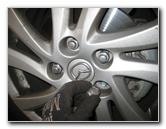 Spin Off 5 Lug Nuts |
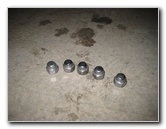 Five Lug Nuts Removed |
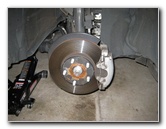 Pull Off Front Wheel |
| The first step is
to park the vehicle on a level surface. Then engage the emergency/parking brake and chock the rear wheels to prevent it from moving. Slightly loosen the 5 lug nuts on the front wheel with the tire iron by turning them counter clockwise. Raise the front of the vehicle with the floor jack and securely support it with two jack stands. (I prefer to work on one side of the car at a time for extra safety.) Spin off the 5 lug nuts and set them aside in a safe place. Pull off the front wheel to reveal the brake caliper, bracket, rotor and suspension. |
||
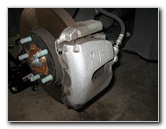 Front Brake Caliper |
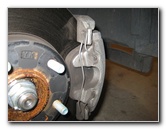 Metal Spring Clip |
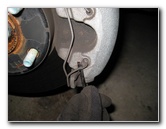 Pry Off Spring Clip |
| Use the flathead
screwdriver to carefully pry off the metal spring clip attached to the front
of the brake caliper.
Set the spring clip aside in a safe place. |
||
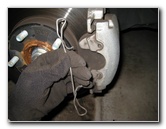 Spring Clip Removed |
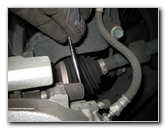 Pry Off Caliper Bolt Cover |
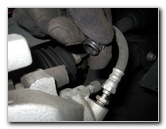 Plastic Cover Removed |
| The two brake
caliper bolts on the rear side of the caliper are hidden by round black
plastic covers. Gently pry off the covers with the flathead screwdriver. |
||
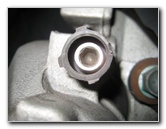 Hex Head Caliper Bolt |
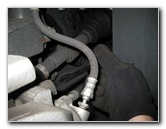 Loosen 7mm Hex Head |
 Pry Off Lower Bolt Cover |
| Loosen the upper caliper bolt with a 7mm hex head socket or a 7mm Allen key wrench by turning it clockwise (as seen from the outside of the vehicle). | ||
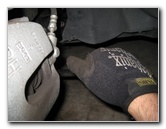 Loosen Lower Caliper Bolt |
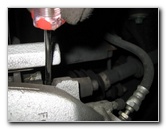 Push Out Caliper Pin / Bolt |
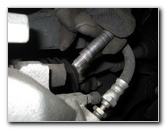 Caliper Bolt/Pin Removed |
| Then loosen the
lower 7mm hex head caliper bolt. Use the blade of the flathead screwdriver to carefully push both of the combination caliper bolts and slider pins out of the caliper. Note - The service manual's torque specification for tightening the front caliper bolts is 19 to 22 lb-ft (or 25 to 30 N*m). |
||
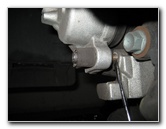 Pry Out Lower Caliper Pin |
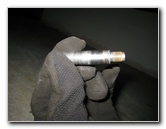 Caliper Combo Bolt & Pin |
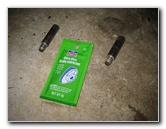 Lubricate Both Caliper Pins |
| In order for the
brake caliper to work properly, the two caliper slider pins need to be well
lubricated.
Apply a thin layer of brake caliper grease to each caliper slider pin and set them aside on a clean surface. |
||
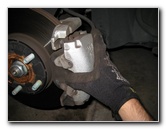 Pull Off Brake Caliper |
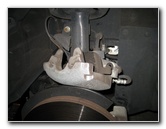 Rest On Suspension |
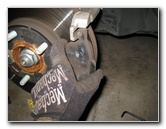 Remove Outer Brake Pad |
| Carefully pull the
brake caliper out of the bracket and either rest it on the suspension or
hang it from the spring with a bungee cord. Pull the old outer brake pad out of the bracket. |
||
|
|
||
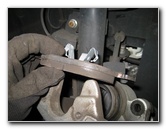 Remove Inner Brake Pad |
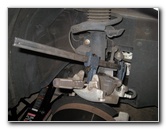 Attach "F" Clamp To Piston |
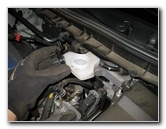 Twist Off Brake Fluid Cap |
| Pull the old inner
brake pad out of the caliper piston. Attach the "C" or "F" clamp to the caliper piston using the back of the old outer pad to evenly distribute the pressure. Move to the right rear area of the engine bay, closest to the driver's seat, and twist off the brake fluid reservoir cap in the counter clockwise direction. Removing the brake fluid cap will allow the fluid to more easily travel backwards through the system when you compress the caliper piston. |
||
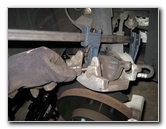 Compress Caliper Piston |
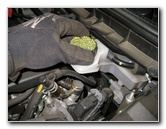 Replace Brake Fluid Cap |
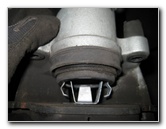 Install New Inner Pad |
| Very slowly
compress the caliper piston with the "F" clamp while repeatedly checking the
brake fluid level in the reservoir. Clean up any spilled brake fluid immediately since brake fluid can easily damage painted surfaces. Only compress the caliper piston as far back as its rubber dust boot while trying to avoid pinching or otherwise damaging the rubber boot. Replace the brake fluid cap as soon as possible since brake fluid is hygroscopic and readily absorbs moisture from the air. Thoroughly clean off the brake rotor, caliper bracket, brake caliper assembly and the lug nut studs with brake parts cleaner spray. Do not use compressed air or blow with your mouth to clean off the brake parts since breathing in brake dust can be harmful to your health. Brake dust can be carcinogenic (causes cancer) if inhaled. Apply a thin layer of brake parts lubricant to any area where there is metal to metal contact such as the outer lip of the caliper piston. Do not apply caliper grease to the friction surface of the new pads. Rotor Replacement Instructions
To remove the existing rotors and install new ones, just remove the two bolts on the rear of the caliper bracket that attach it to the steering knuckle. Then loosen the old rotor with a rubber mallet, pull it off, and slide the new one in its place. Note - The service manual's torque specification for tightening the large front bracket bolts is 61 to 74 lb-ft (82 to 101 N*m). |
||
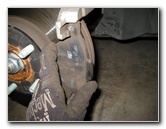 Install New Outer Pad |
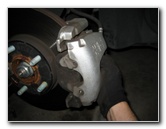 Lower Caliper Over Pads |
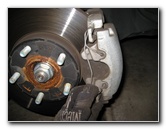 Line Up Metal Spring Clip |
| I recommend buying
the ACDelco
14D1044C brake pads since they have excellent reviews on
Amazon. Push the metal clip on the back side of the new inner pad in to the caliper piston. Install the new outer pad in to the caliper bracket. Lower the brake caliper in to the bracket. Line up the bolt holes in the caliper with the corresponding bolt holes in the bracket. |
||
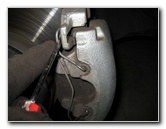 Push Spring Clip In Place |
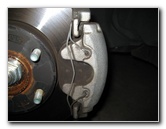 Spring Clip Replaced |
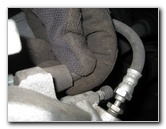 Push In Caliper Bolt/Pin |
| Line up the metal
spring clip on to the outside of the caliper and push it in to place. You
may need to use the flathead screwdriver for extra leverage to re-install
the spring clip. Slide in the lubricated upper and lower caliper bolts/pins in to the back side of the caliper. Insert the threaded ends in first with the hex head end facing towards the center of the vehicle. |
||
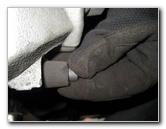 Insert Lower Caliper Bolt |
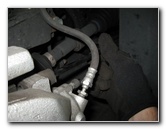 Spin In Upper Caliper Bolt |
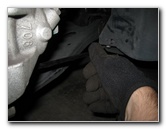 Spin In Lower Caliper Bolt |
| Thread in the two caliper bolts with the 7mm hex head socket or Allen key wrench by turning them counter clockwise (as seen from the outside of the vehicle). | ||
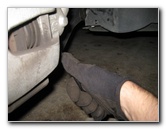 Tighten Lower Bolt |
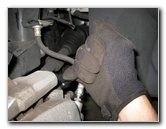 Tighten Upper Caliper Bolt |
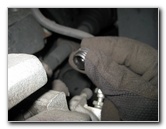 Replace Plastic Bolt Cover |
| Tighten the two
caliper bolts to just past hand tight or about 20-22 ft lbs of torque. Note - The Mazda 3 service manual's torque specification for tightening the front caliper bolts is 19 to 22 lb-ft (or 25 to 30 N*m). Double check that both caliper bolts are tight before moving on to the next steps. Push the two black plastic caliper bolt covers back in place on the rear of the caliper. |
||
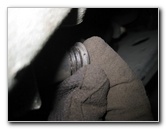 Push In Lower Bolt Cover |
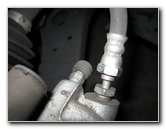 Rubber Valve Cap |
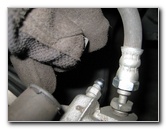 Brake Fluid Bleeder Valve |
|
If your brake pedal previously felt soft or spongy, the brake fluid may be contaminated with water or the brake lines may contain some air bubbles. It would be best to bleed the brake lines at this time in order to flush out the old fluid and replace it with fresh DOT 3 brake fluid. For more on this topic, check out my Brake Line Fluid Bleeding With An Assistant DIY Guide or alternatively the Brake Line Fluid Bleeding With A Power Bleeder Guide. The brake fluid bleeder valve is located underneath a rubber cap on the back side of the caliper just below the upper caliper bolt. Note - The Mazda3 service manual's torque specification for tightening the brake fluid bleeder valve is 62 to 79 in-lb (or 7.0 to 9.0 N*m). |
||
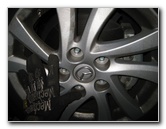 Replace Front Wheel |
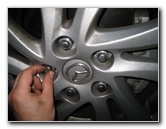 Spin On 5 Lug Nuts |
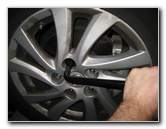 Slightly Tighten Lug Nuts |
| Replace the front
wheel and spin on the 5 lug nuts by hand to prevent them from becoming cross
threaded. Slightly tighten the 5 lug nuts in a "criss cross" or star pattern with the tire iron. |
||
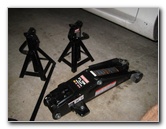 Lower Vehicle From Jack |
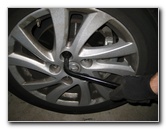 Torque Lug Nuts |
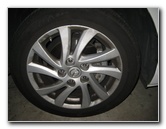 Front Brake Pads Replaced |
| Lower the front of
the vehicle from the jack stands using the floor jack. Continue tightening the lug nuts in a criss cross or star pattern to about 1/4 to 1/3 turn past hand tight or about 75-80 ft lbs of torque. It would be best to use a torque wrench or an impact wrench with a torque stick to properly tighten the lug nuts. Note - The owner's manual torque specification for tightening the lug nuts is 65 to 87 lb-ft (or 88 to 118 N*m). Sit in the driver's seat of the vehicle and pump the brake pedal a few times to restore the brake line pressure. Check the brake fluid in the reservoir and verify that it is at the proper level. If it is low, add some DOT 3 fluid. To break in your new front brake pads, just drive normally for the first several hundred miles while trying to avoid any hard or "panic" stops which may glaze over the new pads and cause them to be noisy and not perform as well. It's also a good idea to regularly check your driveway for drops of brake fluid which may indicate a leak, check the brake fluid level in the reservoir, and also verify that the lug nuts are still tight. For more, check out my other
2010-2013 Mazda Mazda3 Repair & Maintenance Guides. |
||
| If you found this guide to be helpful,
please consider making a small donation by clicking on the PayPal.com
"Donate" button located to the right of this paragraph. Thank you!
(Note: I am not a registered charity. Donations are not tax deductible.) |

